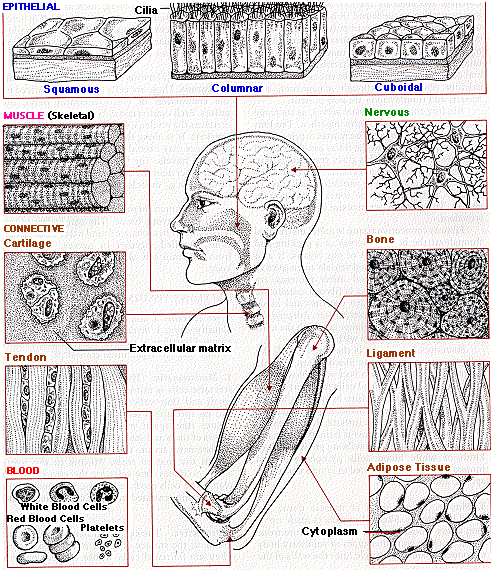
| Index to this page |
The development of a fertilized egg into a newborn child requires an average of 41 rounds of mitosis (241 = 2.2 x 1012). During this period, the cells produced by mitosis enter different pathways of differentiation; some becoming blood cells, some muscle cells, and so on.
There are more than 100 visibly-distinguishable kinds of differentiated cells in the vertebrate animal. These are organized into tissues; the tissues into organs. Groups of organs make up the various systems - digestive, excretory, etc. - of the body.
The actual number of differentiated cell types is surely much larger than 100.
|
This page will give a brief introduction to the major types of animal tissues. The links along the left side of the figure will take you directly to the individual paragraphs indicated.
| Epithelial | 
|
| Muscle | |
| Connective | |
| Nerve | |
| Blood |
Epithelial tissue is made of closely-packed cells arranged in flat sheets. Epithelia form the surface of the skin and line the various cavities and tubes of the body. The epithelia that form the inner lining of blood and lymph vessels are called endothelia.
The apical surface of epithelial cells is exposed to the "external environment", the lumen of the organ or the air. [View example]The basolateral surface is exposed to the internal environment (ECF). The entire sheet of epithelial cells is attached to a layer of extracellular matrix that is called the basement membrane or, better (because it is not a membrane in the biological sense), the basal lamina. [View example]
| View showing relationship between the apical and basolateral surfaces of epithelial cells and how they maintain their distinction. |
The function of epithelia always reflects the fact that they are boundaries between masses of cells and a cavity or space. Some examples:
| Link to page devoted to the structure and properties of the three kinds of muscles. |
It is distributed throughout the body. It serves as a packing and binding material for most of our organs. Collagen, elastin, and other proteins are found in the matrix.
Fascia is fibrous connective tissue that binds muscle together and binds the skin to the underlying structures.
Adipose tissue is fibrous connective tissue in which the cells have become almost filled with oil. The cells of adipose tissue, called adipocytes, secrete several hormones, including leptin and adiponectin.
All forms of connective tissue are derived from cells called fibroblasts [View], which secrete the extracellular matrix.
The nerve impulse is conducted along the axon.
| Link to a page devoted to neuron structure. |
The tips of axons meet:
| Link to a page describing the properties of synapses. |
| Link here to a page describing the neuromuscular junction. |
| Link here to a page describing how neurons work. |
| Link here to a page describing the types and organization of neurons in the peripheral nervous system. |
There are three types:
In addition, the central nervous system contains many microglia — mobile cells that respond to damage (e.g., from an infection) by
| Link here to a page describing the blood cells in detail. |
| Welcome&Next Search |